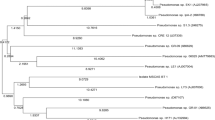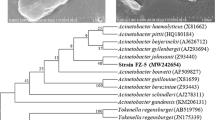Abstract
Biodegradation of endosulfan, a chlorinated cyclodiene insecticide, is generally accompanied by production of the more toxic and more persistent metabolite, endosulfan sulfate. Since our reported endosulfan degrader, Klebsiella pneumoniae KE-1, failed to degrade endosulfan sulfate, we tried to isolate an endosulfan sulfate degrader from endosulfan-polluted soils. Through repetitive enrichment and successive subculture using mineral salt medium containing endosulfan or endosulfan sulfate as the sole source of carbon and energy, we isolated a bacterium capable of degrading endosulfan sulfate as well as endosulfan. The bacterium KE-8 was identified as Klebsiella oxytoca from the results of 16S rDNA sequence analysis. In biodegradation assays with KE-8 using mineral salt medium containing endosulfan (150 mg l−1) or endosulfan sulfate (173 mg l−1), the biomass was rapidly increased to an optical density at 550 nm of 1.9 in 4 days and the degradation constants for α- and β-endosulfan, and endosulfan sulfate were 0.3084, 0.2983 and 0.2465 day−1, respectively. Analysis of the metabolites further suggested that K. oxytoca KE-8 has high potential as a biocatalyst for bioremediation of endosulfan and/or endosulfan sulfate.



Similar content being viewed by others
References
Awasthi N, Singh AK, Jain RK, Khangarot BS, Kumar A (2003) Degradation and detoxification of endosulfan isomers by a defined co-culture of two Bacillus strains. Appl Microbiol Biotechnol 62:279–283
Awasthi N, Manickam N, Kumar A (1997) Biodegradation of endosulfan by a bacterial coculture. Bull Environ Contam Toxicol 59:928–934
Goebel H, Gorbach S, Knauf W, Rimpau RH, Huttenbach H (1982) Properties, effect, residues and analytics of the insecticide endosulfan. Residue Rev 83:1–122
Kaur I, Mathur RP, Tandon SN, Dureja P (1998) Persistence of endosulfan (technical) in water and soil. Environ Technol 19:115–119
Knoevenagel K, Himmelreich R (1976) Degradation of compounds containing carbon atoms by photo-oxidation in the presence of water. Arch Environ Contam Toxicol 4:324–333
Kullman SW, Matsumura F (1996) Metabolic pathways utilized by Phanerochaete chrysosporium for degradation of the cyclodiene pesticide endosulfan. Appl Environ Microbiol 62:593–600
Kwon G-S, Kim J-E, Kim T-K, Sohn H-Y, Koh S-C, Shin K-S, Kim D-G (2002) Klebsiella pneumoniae KE-1 degrades endosulfan without formation of the toxic metabolite, endosulfan sulfate. FEMS Microbiol Lett 215:255–259
Lee S-E, Kim J-S, Kennedy IR, Park J-W, Kwon G-S, Koh S-C, Kim J-E (2003) Biotransformation of an organochlorine insecticide, endosulfan, by Anabaena species. J Agric Food Chem 51:1336–1340
Maier-Bode H (1968) Properties, effect, residues, and analytics of the insecticide endosulfan. Residue Rev 22:1–44
Rao DMR, Murty AS (1980) Persistence of endosulfan in soils. J Agric Food Chem 28:1099–1101
Sethunathan N, Megharaj M, Chen ZL, Williams BD, Lewis G, Naidu R (2004) Algal degradation of a known endocrine disrupting insecticide, α-endosulfan, and its metabolite, endosulfan sulfate, in liquid medium and soil. J Agric Food Chem 52:3030–3035
Siddique T, Okeke BC, Arshad M, Frankenberger WT Jr (2003) Biodegradation kinetics of endosulfan by Fusarium ventricosum and a Pandoraea species. J Agric Food Chem 51:8015–8019
Sohn H-Y, Kwon C-S, Kwon G-S, Lee J-B, Kim E (2004) Induction of oxidative stress by endosulfan and protective effect of lipid-soluble antioxidants against endosulfan-induced oxidative damage. Toxicol Lett 151:357–365
Stewart DKR, Cairns KG (1974) Endosulfan persistence in soil and uptake by potato tubers. J Agric Food Chem. 22:984–986
Strotmann U (2000) Futher development of the biological degradation test procedure considering respirometry. In: 1st Symposium on Biological Degradability, 1–10
Sutherland TD, Horne I, Harcourt RL, Russell RJ, Oakeshott JG (2002a) Gene cloning and molecular characterization of a two-enzyme system catalyzing the oxidative detoxification of β-endosulfan. Appl Environ Microbiol 68:6237–6245
Sutherland TD, Horne I, Harcourt RL, Russell RJ, Oakeshott JG (2002b) Isolation and characterization of a Mycobacterium strain that metabolizes the insecticide endosulfan. J Appl Microbiol 93:380–389
Sutherland TD, Horne I, Lacey MJ, Harcourt RL, Russell RJ, Oakeshott JG (2000) Enrichment of an endosulfan-degrading mixed bacterial culture. Appl Environ Microbiol 66:2822–2828
Sutherland TD, Weir KM, Lacey MJ, Horne I, Russell RJ, Oakeshott JG (2002c) Enrichment of a microbial culture capable of degrading endosulphate, the toxic metabolite of endosulfan. J Appl Microbiol 92:541–548
Verschueren K (1999) Handbook of environmental data of organic chemicals, 4th edn. Wiley, New York
Yoon JH, Lee ST, Kim SB, Kim WY, Goodfellow M, Park YH (1997) Restriction fragment length polymorphism analysis of PCR-amplified 16S ribosomal DNA for rapid identification of Saccharomonospora strains. Int J Syst Bacteriol 47:111–114
Acknowledgements
This work was supported by a grant from BioGreen21 program, Rural Development administration, Republic of Korea (1000520030096000).
Author information
Authors and Affiliations
Corresponding author
Rights and permissions
About this article
Cite this article
Kwon, GS., Sohn, HY., Shin, KS. et al. Biodegradation of the organochlorine insecticide, endosulfan, and the toxic metabolite, endosulfan sulfate, by Klebsiella oxytoca KE-8. Appl Microbiol Biotechnol 67, 845–850 (2005). https://doi.org/10.1007/s00253-004-1879-9
Received:
Revised:
Accepted:
Published:
Issue Date:
DOI: https://doi.org/10.1007/s00253-004-1879-9




